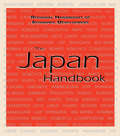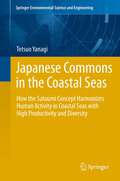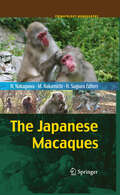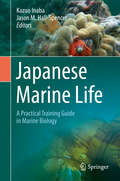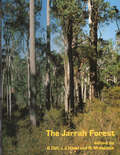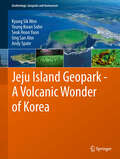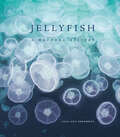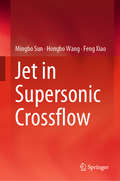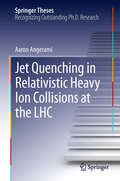- Table View
- List View
The Japan Handbook (Regional Handbooks of Economic Development #Vol. 3)
by Patrick HeenanFirst Published in 1999. Routledge is an imprint of Taylor & Francis, an informa company.
Japanese Advance into the Pacific Ocean: The Albatross and the Great Bird Rush (International Perspectives in Geography #7)
by Akitoshi HiraokaThis book asserts that the albatross was the reason for the advance of the Japanese into the isolated islands in the Pacific after the abolition of the Japanese “closed-door” policy that had been in effect from the seventeenth century to the latter part of the nineteenth century. The birds’ plumage was of high quality and sold at quite a good price in Europe. The Japanese realized the advantage of this global trade, and their desire to capture albatross motivated them to advance into the Pacific. The exploration of the uninhabited islands had become a fast-moving trend, defined by the author as the “Bird Rush”. As a consequence, the advance into the Pacific by the Japanese resulted in the expansion of Japanese territory. The author has interpreted this Japanese movement into the Pacific by making use of the framework of three distinct shifts: in the aim of their actions from birds to guano / phosphate ore, in the agents of action from individual speculators to commercial capital and then to monopolistic capital, and from the sea near Japan to the wider Pacific. This concept can be termed “a view of history centered on the albatross”.
Japanese Commons in the Coastal Seas: How the Satoumi Concept Harmonizes Human Activity in Coastal Seas with High Productivity and Diversity
by Tetsuo YanagiThe author proposed the satoumi concept, analogous to the satoyama concept on land, as “coastal sea with high biodiversity and productivity in harmony with human interaction” in 1998. The concept for environmental conservation in the coastal seas has been widely accepted and was included in the Japanese national policy of “Strategy for Establishment of an Environmental Nation” in 2007. This book is a translation of the author’s Japanese book (2010) in response to concerns and questions about satoumi, including: Does biodiversity increase as a result of human interaction in coastal seas? Do the economics of fishing villages need to be considered in detail? What legal support is necessary for the creation of satoumi? Is there a relation between the concepts of God and Nature in satoumi? What is the relationship between fishermen and city dwellers? Chapter 1 presents the basic concept of satoumi. In Chapter 2 the relation between biodiversity and human interaction, economic problems related to satoumi, legal support for satoumi creation, satoumi from the point of view of landscape ecology, and the relation between society and science with regard to the satoumi movement are discussed. In Chapter 3 examples of satoumi creation in Japan are presented, and in Chapter 4 the overseas dissemination of the satoumi concept is introduced, with Chapter 5 providing the conclusion. Chapter 1 presents the basic concept of satoumi. In Chapter 2 the relation between biodiversity and human interaction, economic problems related to satoumi, legal support for satoumi creation, satoumi from the point of view of landscape ecology, and the relation between society and science with regard to the satoumi movement are discussed. In Chapter 3 examples of satoumi creation in Japan are presented, and in Chapter 4 the overseas dissemination of the satoumi concept is introduced, with Chapter 5 providing the conclusion.
Japanese Corporate Transition in Time and Space
by T. KuriharaThis book is an ethnography of a Japanese white-collar workplace in Osaka carried out during the late 1990s. It explores the relevance of social models to the analysis of social relations and women's status in the workplace by examining concepts of time, ritual, and space via the theory of practice.
The Japanese Macaques (Primatology Monographs)
by Naofumi Nakagawa Masayuki Nakamichi Hideki SugiuraJapanese macaques (Macaca fuscata) have been studied by primatologists since 1948, and considerable knowledge of the primate has been accumulated to elucidate the adaptation of the species over time and to distinct environments in Japan. The Japanese macaque is especially suited to intragenera and interpopulation comparative studies of behavior, physiology, and morphology, and to socioecology studies in general. This book, the most comprehensive ever published in English on Japanese macaques, is replete with contributions by leading researchers in field primatology. Highlighted are topics of intraspecific variations in the ecology and behaviors of the macaque. Such variations provide evidence of the ecological determinants on this species’ mating and social behaviors, along with evidence of cultural behavior. The book also addresses morphology, population genetics, recent habitat change, and conflicts with humans, and attests to the plasticity and complex adaptive system of macaque societies. The valuable information in this volume is recommended reading for researchers in primatology, anthropology, zoology, animal behavior, and conservation biology.
Japanese Marine Life: A Practical Training Guide in Marine Biology
by Kazuo Inaba Jason M. Hall-SpencerThis book gives an overview of the diverse marine fauna and flora of Japan and includes practical guides for investigating the biology and ecology of marine organisms. Introducing marine training courses offered at a range of Japanese universities, this is the first English textbook intended for marine biology instructors and students in Japan. It provides essential information on experimental procedures for the major areas of marine biology, including cell and developmental biology, physiology, ecology and environmental sciences, and as such is a valuable resource for those in Asian countries that share a similar flora and fauna. It also appeals to visitors interested in attending Japanese marine courses from countries around the world.
Japanese Urban System (GeoJournal Library #56)
by Yuji MurayamaThis book is an attempt to explain Japanese regional structure and associated dynamism in terms of urban systems. It is extremely effective to use the urban systems approach to explain the regional changes in today's Japan, which is undergoing changes wrought by economic globalization and the information revolution. This is because the transformation into a service economy has become the key component of the economic activities of cities, linkages are being mutually strengthened, and regional development is being determined by the interdependency of cities. Readers hoping to gain an understanding of the regional geography of Japan may feel that the structure and content of this book are lacking something. However, it is not the intention of this book to systematically paint a total geographical image of Japan within the context of East Asia. Instead, by focusing on urban systems theory, it might be possible to theorize about the factors related to the changing geography of Japan, such as the growth and decline processes of Japanese urban systems, the strengthening of ties among cities and associated factors, and the expansion of socioeconomic exchanges with cities overseas, from a perspective that is different from the conventional approach.
Japan's Withdrawal from International Whaling Regulation (Routledge Studies in Conservation and the Environment)
by Nikolas Sellheim Joji MorishitaThis book examines the impact and implications of Japan’s withdrawal from the International Convention for the Regulation of Whaling (ICRW), which came into effect in July 2019. In 1982 the International Whaling Commission (IWC) adopted a moratorium on commercial whaling which has been in effect ever since, despite the resistance of some countries, first and foremost Japan, Norway and Iceland, that engage in commercial whaling. As one of the key contributors to scientific research and funding, Japan’s withdrawal has the potential to have wide-ranging implications and this volume examines the impact of Japan’s withdrawal on the IWC itself, on the governance of whaling, and on indigenous and coastal whaling. It provides backgrounds and commentaries on this decision as well as normative and legal discussions on matters relating to sustainable use of resources, and philosophies surrounding whaling in different IWC countries. The consideration of other international environmental regimes, such as the Convention on International Trade in Endangered Species of Wild Fauna and Flora (CITES), is also examined in order to determine the international ripple effect of Japan’s decision. The book reveals that this is not just a matter of whaling but one which has significant legal, managerial and cultural implications. Drawing on deep analyses of IWC structures, the book addresses core philosophies underlying the whaling debate and in how far these may influence environmental governance in the future. This book will be of great interest to students and scholars of environmental law and governance, biodiversity conservation and sustainable development, as well as policymakers involved in international environmental and conservation agreements.
Japan's Withdrawal from International Whaling Regulation: Implications For Global Environmental Diplomacy (Routledge Studies in Conservation and the Environment)
by Nikolas Sellheim Joji MorishitaThis book examines the impact and implications of Japan’s withdrawal from the International Convention for the Regulation of Whaling (ICRW), which came into effect in July 2019. In 1982 the International Whaling Commission (IWC) adopted a moratorium on commercial whaling which has been in effect ever since, despite the resistance of some countries, first and foremost Japan, Norway and Iceland, that engage in commercial whaling. As one of the key contributors to scientific research and funding, Japan’s withdrawal has the potential to have wide-ranging implications and this volume examines the impact of Japan’s withdrawal on the IWC itself, on the governance of whaling, and on indigenous and coastal whaling. It provides backgrounds and commentaries on this decision as well as normative and legal discussions on matters relating to sustainable use of resources, and philosophies surrounding whaling in different IWC countries. The consideration of other international environmental regimes, such as the Convention on International Trade in Endangered Species of Wild Fauna and Flora (CITES), is also examined in order to determine the international ripple effect of Japan’s decision. The book reveals that this is not just a matter of whaling but one which has significant legal, managerial and cultural implications. Drawing on deep analyses of IWC structures, the book addresses core philosophies underlying the whaling debate and in how far these may influence environmental governance in the future. This book will be of great interest to students and scholars of environmental law and governance, biodiversity conservation and sustainable development, as well as policymakers involved in international environmental and conservation agreements.
The Jarrah Forest: A complex mediterranean ecosystem (Geobotany #13)
by Bernard Dell J. J. Havel N. MalajczukThe Western Australian jarrah forest is unique, contammg some of the most beautiful flora in the world, more than 100 species of birds and some 50 mammals indigenous to this State. This book "The Jarrah Forest - A Complex Mediterranean Ecosystem" is a collection of scholarly essays on every known aspect of the northern part of the jarrah forest extending from south of Collie to the Avon River. All of the work has been researched by members of tertiary institutions, the private sector and government instrumentalities and was prepared expressly for this book. In the list of contributors are the names of many Western Australians who are in the forefront of their particular field. The book will be a very important reference work for senior secondary schools and tertiary institutions in Western Australia for many years to come. Additionally, it will have wide appeal to all interested in forestry management, both in Australia and overseas. I should like to express my appreciation for the efforts of all those involved in the conception and planning of this most valuable book. Perth, August 1988 Peter Dowding LL.B. M.L.A.
Javatrekker: Dispatches from the World of Fair Trade Coffee
by Dean CyconIn each cup of coffee we drink the major issues of the twenty-first century-globalization, immigration, women's rights, pollution, indigenous rights, and self-determination-are played out in villages and remote areas around the world. In Javatrekker: Dispatches from the World of Fair Trade Coffee, a unique hybrid of Fair Trade business, adventure travel, and cultural anthropology, author Dean Cycon brings readers face-to-face with the real people who make our morning coffee ritual possible. Second only to oil in terms of its value, the coffee trade is complex with several levels of middlemen removing the 28 million growers in fifty distant countries far from you and your morning cup. And, according to Cycon, 99 percent of the people involved in the coffee economy have never been to a coffee village. They let advertising and images from the major coffee companies create their worldview. Cycon changes that in this compelling book, taking the reader on a tour of ten countries in nine chapters through his passionate eye and unique perspective. Cycon, who is himself an amalgam-equal parts entrepreneur, activist, and mischievous explorer-has traveled extensively throughout the world's tropical coffeelands, and shows readers places and people that few if any outsiders have ever seen. Along the way, readers come to realize the promise and hope offered by sustainable business principles and the products derived from cooperation, fair pricing, and profit sharing. Cycon introduces us to the Mamos of Colombia-holy men who believe they are literally holding the world together-despite the severe effects of climate change caused by us, their "younger brothers." He takes us on a trip through an ancient forest in Ethiopia where many believe that coffee was first discovered 1,500 years ago by the goatherd Kaldi and his animals. And readers learn of Mexico's infamous Death Train, which transported countless immigrants from Central America northward to the U.S. border, but took a horrifying toll in lost lives and limbs. Rich with stories of people, landscapes, and customs, Javatrekker offers a deep appreciation and understanding of the global trade and culture of coffee. In each cup of coffee we drink the major issues of the twenty-first century-globalization, immigration, women's rights, pollution, indigenous rights, and self-determination-are played out in villages and remote areas around the world. What is Fair Trade Coffee? Coffee prices paid to the farmer are based on the international commodity price for coffee (the "C" price) and the quality premium each farmer negotiates. Fair Trade provides an internationally determined minimum floor price when the C plus premium sinks below $1.26 per pound for conventional and $1.41 for organics (that's us!). As important as price, Fair Trade works with small farmers to create democratic cooperatives that insure fair dealing, accountability and transparency in trade transactions. In an industry where the farmer is traditionally ripped off by a host of middlemen, this is tremendously important. Cooperatives are examined by the Fairtrade Labeling Organization (FLO), or the International Fair Trade Association (IFAT), European NGOs, for democratic process and transparency. Those that pass are listed on the FLO Registry or become IFAT members. Cooperatives provide important resources and organization to small farmers in the form of technical assistance for crop and harvest improvement, efficiencies in processing and shipping, strength in negotiation and an array of needed social services, such as health care and credit. Fair Trade also requires pre-financing of up to sixty percent of the value of the contract, if the farmers ask for it. Several groups, such as Ecologic and Green Development Fund have created funds for pre-finance lending.
Jean Leray ’99 Conference Proceedings: The Karlskrona Conference in Honor of Jean Leray (Mathematical Physics Studies #24)
by Maurice De GossonJeju Island Geopark - A Volcanic Wonder of Korea (Geoheritage, Geoparks and Geotourism #1)
by Kyung Sik Woo Young Kwan Sohn Seok Hoon Yoon Ung San Ahn Andy SpateThis book will deal with geological as well as cultural, historical, archaeological and biological aspects in Jeju Global Geopark. It will start with introduction of Jeju Global Geopark, geographic setting, habitats, history, economy and tourism, management, general geology and geosites, future geosites, other significant heritage sites, economically sustainable tourism, education and promotion and management plan.
Jellyfish: A Natural History
by Lisa-ann GershwinJellyfish, with their undulating umbrella-shaped bells and sprawling tentacles, are as fascinating and beautiful as they are frightening and dangerous. They are found in every ocean at every depth, and they are the oldest multi-organed life form on the planet, having inhabited the ocean for more than five hundred million years. In many places they are also vastly increasing in number, and these population blooms may be an ominous indicator of the rising temperatures and toxicity of the world’s oceans. Jellyfish presents these aquarium favorites in all their extraordinary and captivating beauty. Fifty unique species, from stalked jellyfish to black sea nettles, are presented in stunning color photographs along with the most current scientific information on their anatomy, history, distribution, position in the water, and environmental status. Foremost jellyfish expert Lisa-ann Gershwin provides an insightful look at the natural history and biology of each of these spellbinding creatures, while offering a timely take on their place in the rapidly changing and deteriorating condition of the oceans. Readers will learn about immortal jellyfish who live and die and live again as well as those who camouflage themselves amid sea grasses and shells, hiding in plain sight. Approachably written and based in the latest science and ecology, this colorful book provides an authoritative guide to these ethereal marine wonders.
Jellyfish: A Natural History
by Lisa-ann GershwinJellyfish, with their undulating umbrella-shaped bells and sprawling tentacles, are as fascinating and beautiful as they are frightening and dangerous. They are found in every ocean at every depth, and they are the oldest multi-organed life form on the planet, having inhabited the ocean for more than five hundred million years. In many places they are also vastly increasing in number, and these population blooms may be an ominous indicator of the rising temperatures and toxicity of the world’s oceans. Jellyfish presents these aquarium favorites in all their extraordinary and captivating beauty. Fifty unique species, from stalked jellyfish to black sea nettles, are presented in stunning color photographs along with the most current scientific information on their anatomy, history, distribution, position in the water, and environmental status. Foremost jellyfish expert Lisa-ann Gershwin provides an insightful look at the natural history and biology of each of these spellbinding creatures, while offering a timely take on their place in the rapidly changing and deteriorating condition of the oceans. Readers will learn about immortal jellyfish who live and die and live again as well as those who camouflage themselves amid sea grasses and shells, hiding in plain sight. Approachably written and based in the latest science and ecology, this colorful book provides an authoritative guide to these ethereal marine wonders.
Jellyfish: A Natural History
by Lisa-ann GershwinJellyfish, with their undulating umbrella-shaped bells and sprawling tentacles, are as fascinating and beautiful as they are frightening and dangerous. They are found in every ocean at every depth, and they are the oldest multi-organed life form on the planet, having inhabited the ocean for more than five hundred million years. In many places they are also vastly increasing in number, and these population blooms may be an ominous indicator of the rising temperatures and toxicity of the world’s oceans. Jellyfish presents these aquarium favorites in all their extraordinary and captivating beauty. Fifty unique species, from stalked jellyfish to black sea nettles, are presented in stunning color photographs along with the most current scientific information on their anatomy, history, distribution, position in the water, and environmental status. Foremost jellyfish expert Lisa-ann Gershwin provides an insightful look at the natural history and biology of each of these spellbinding creatures, while offering a timely take on their place in the rapidly changing and deteriorating condition of the oceans. Readers will learn about immortal jellyfish who live and die and live again as well as those who camouflage themselves amid sea grasses and shells, hiding in plain sight. Approachably written and based in the latest science and ecology, this colorful book provides an authoritative guide to these ethereal marine wonders.
Jellyfish: A Natural History
by Lisa-ann GershwinJellyfish, with their undulating umbrella-shaped bells and sprawling tentacles, are as fascinating and beautiful as they are frightening and dangerous. They are found in every ocean at every depth, and they are the oldest multi-organed life form on the planet, having inhabited the ocean for more than five hundred million years. In many places they are also vastly increasing in number, and these population blooms may be an ominous indicator of the rising temperatures and toxicity of the world’s oceans. Jellyfish presents these aquarium favorites in all their extraordinary and captivating beauty. Fifty unique species, from stalked jellyfish to black sea nettles, are presented in stunning color photographs along with the most current scientific information on their anatomy, history, distribution, position in the water, and environmental status. Foremost jellyfish expert Lisa-ann Gershwin provides an insightful look at the natural history and biology of each of these spellbinding creatures, while offering a timely take on their place in the rapidly changing and deteriorating condition of the oceans. Readers will learn about immortal jellyfish who live and die and live again as well as those who camouflage themselves amid sea grasses and shells, hiding in plain sight. Approachably written and based in the latest science and ecology, this colorful book provides an authoritative guide to these ethereal marine wonders.
Jellyfish Blooms: Proceedings of the International Conference on Jellyfish Blooms, held in Gulf Shores, Alabama, 12–14 January 2000 (Developments in Hydrobiology #155)
by J. E. Purcell W. M. Graham Henri J. Dumont`Jellyfish', a group that includes scyphomedusae, hydromedusae, siphonophores and ctenophores, are important zooplankton predators throughout the world's estuaries and oceans. These beautiful creatures have come to public attention as featured exhibits in aquaria and in news headlines as invaders and as providers of genes used in biomedical research. Nevertheless, jellyfish are generally considered to be nuisances because they interfere with human activities by stinging swimmers, clogging power plant intakes and nets of fishermen and fish farms, and competing with fish and eating fish eggs and larvae. There is concern that environmental changes such as global warming, eutrophication, and over-fishing may result in increased jellyfish populations. The literature reviews and research papers in this volume explore the interactions between jellyfish and humans. Papers cover the medical aspects of jellyfish stings, jellyfish as human food and jellyfish fisheries, interactions of jellyfish and fish, effects of environmental changes on jellyfish, effects of introduced ctenophores on the Black Sea ecosystem, factors causing increases or concentrations of jellyfish, and others aspects of jellyfish ecology. This is an important reference for students and professional marine biologists, oceanographers, fishery scientists, and aquarists.
Jellyfish Blooms IV: Interactions with humans and fisheries (Developments in Hydrobiology #220)
by Jennifer Purcell Hermes Mianzan Jessica R. FrostJellyfish generally are considered to be nuisances because they interfere with human activities by stinging swimmers, clogging power plant intakes and nets of fishermen, killing fish in aquaculture pens, and being both predators and competitors of fish. There is concern that environmental changes such as global warming, eutrophication, over-fishing, and coastal construction may benefit jellyfish populations. During this past decade following the first Jellyfish Blooms volume, some species have bloomed more frequently, expanded their range, and caused more problems for humans. Mnemiopsis leidyi, the ctenophore that invaded the Black Sea in the 1980s and damaged fisheries, now also blooms in the North, Baltic, and Mediterranean seas. Nemopilema nomurai, a giant Asian jellyfish, has bloomed frequently during this decade, causing severe damage to the Japanese fishing industry. Jellyfish Blooms: Interactions with Humans and Fisheries is the fourth volume in this series. Syntheses and original research articles address the question if jellyfish have increased globally and what factors may have contributed to the abundance of jellyfish. This volume is the most extensive to date, containing papers from all continents (except Antarctica) on scyphozoans, hydrozoans, cubozoans, staurozoans, and ctenophores, and on the fate of jellyfish blooms. This is a key reference for students and professional marine biologists, oceanographers, and fishery scientists and managers. Previously published in Hydrobiologia, vol. 690, 2012
Jenseits von Halley: Die Erforschung von Schweifsternen durch die Raumsonden GIOTTO und ROSETTA
by Nigel CalderBegleiten Sie eines der spektakulärsten Raumprojekte seit der Mondlandung! Das Buch führt Sie durch alle Fehlschläge und glanzvollen Erfolge der GIOTTO-Mission und geht auf das aktuelle ROSETTA-Projekt ein.
Jerusalem Online: Critical Cartography for the Digital Age (The Contemporary City)
by Valentina CarraroThe book addresses the rapid shifts which have taken place within cartography, and argues that no amount of technological sophistication will lead to neutral representations, and that as such critical cartography provides a solid foundation for questioning the power of maps. It considers the fragmentation, dynamism and opacity that characterise online maps, and argues for the need of new ways of thinking and researching maps. The book offers an approach grounded in ‘ontological’ social theory and feminist technoscience, and illustrates it through the analysis of three Jerusalem-related mapping controversies. Using online media, historical maps and ethnographic work, each case study explores a different map provider and a recent mapping development: Google Maps and the distributed authorship of web-maps; Waze and algorithmic navigation; OpenStreetMap and crowdsourcing. The book is a key read to faculty and advanced students in Urban Studies and Critical Cartography. It will particularly appeal to those working in the digital geographies
Jet Grouting: Technology, Design and Control
by Paolo Croce Alessandro Flora Giuseppe ModoniUnlike similar titles providing general information on ground improvement, Jet Grouting: Technology, Design and Control is entirely devoted to the role of jet grouting - its methods and equipment, as well as its applications. It discusses the possible effects of jet grouting on different soils and examines common drawbacks, failures and disadvantag
Jet in Supersonic Crossflow
by Mingbo Sun Hongbo Wang Feng XiaoBased on research into jets in supersonic crossflow carried out by the authors’ team over the past 15 years, this book summarizes and presents many cutting-edge findings and analyses on this subject. It tackles the complicated mixing process of gas jets and atomization process of liquid jets in supersonic crossflow, and studies their physical mechanisms. Advanced experimental and numerical techniques are applied to further readers’ understanding of atomization, mixing, and combustion of fuel jets in supersonic crossflow, which can promote superior fuel injection design in scramjet engines. The book offers a valuable reference guide for all researchers and engineers working on the design of scramjet engines, and will also benefit graduate students majoring in aeronautical and aerospace engineering.
Jet Quenching in Relativistic Heavy Ion Collisions at the LHC (Springer Theses)
by Aaron AngeramiThis thesis presents the first measurements of jets in relativistic heavy ion collisions as reported by the ATLAS Collaboration. These include the first direct observation of jet quenching through the observation of a centrality-dependent dijet asymmetry. Also, a series of jet suppression measurements are presented, which provide quantitative constraints on theoretical models of jet quenching. These results follow a detailed introduction to heavy ion physics with emphasis on the phenomenon of jet quenching and a comprehensive description of the ATLAS detector and its capabilities with regard to performing these measurements.
JET Simulations, Experiments, and Theory: Ten Years After JETSET. What Is Next? (Astrophysics and Space Science Proceedings #55)
by Christophe SautyIn 2008, the European FP6 JETSET project ended. JETSET, for Jet, Simulations, Experiments, and Theory, was a joint research network of European expert teams on protostellar jets. The present proceedings are a collection of contributions presenting new results obtained by those groups since the end of the JETSET program. This is also the occasion to celebrate Kanaris Tsinganos’ important contributions to this network and for his enlightening insight in the subject that inspired us all. Some of the former JETSET students are now in the academic world and the subject has never been so alive. So we present here a collection of results of what has been done in the field of protostellar jets in the past ten years from the theoretical, numerical, observational and experimental point of view. We also present new challenges in the field of protostellar jets and what we should expect from the development of new instruments and new numerical codes in the near future. We also gather results on the impact of the study of protostellar jets on other jet studies in particular on relativistic jets. As a matter of fact, it is time for a new network.
